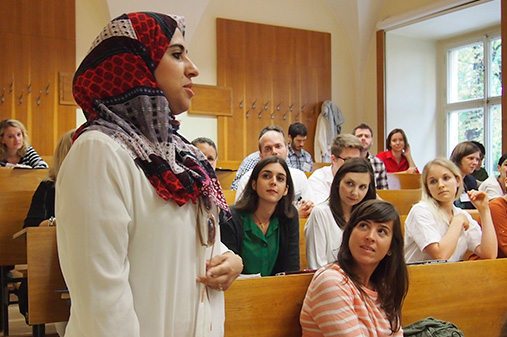Expanded and Independent Spanish Validation of the MDS Non-Motor Rating Scale
MDS Non-motor Rating Scale
[00:00:00] Dr. Sarah Lidstone:
Hello everybody and welcome to the International Parkinson's and Movement Disorders official podcast. I'm your host, Dr. Sarah Lidstone from the University of Toronto and today I have the pleasure of interviewing Dr. Esther Cubo, someone I've wanted to meet for many years from the University of Burgos in Spain on her recent publication in Movement Disorders Clinical Practice called Expanded and Independent Spanish Validation of the MDS Non Motor Rating Scale. So welcome, Esther. Pleasure to have you.
View complete transcript
[00:00:31] Mr. Esther Cubo: Thank you very much.
[00:00:33] Dr. Sarah Lidstone: Right, so I just want to off the bat, just start by asking why was a Spanish MDS non motor symptom scale version needed in our field?
[00:00:41] Mr. Esther Cubo: The benefits of translating are validating the movement disorder and non motor symptoms rating a scale into a Spanish will include the possibility for reaching a million of individuals worldwide, including healthcare professionals and patients with Parkinson's disease, approximately a[00:01:00] 21 countries worldwide speak spanish as the official language and represents the fourth language most frequently spoken in the world after English, Chinese, and Hindi by more than 500 million people. Geographically, it includes Spain, Europe, and America, North, Central, and South America with a representation of high income and low middle income countries.
[00:01:28] Dr. Sarah Lidstone: I mean, it's, it's a huge project in terms of scale. When I read how many countries were involved, it was actually quite surprising to me as well. And, and maybe could you just speak a little bit about which countries were included and, and were there any gaps in the ones that you had wanted to include and weren't able to participate?
[00:01:46] Mr. Esther Cubo: We included patients from Spain, Argentina, Mexico, Colombia, Ecuador, Cuba, USA, actually 2 sites from Miami, and we selected countries based on the availability and [00:02:00] experience on conducting validation studies for new disorder rating scales. Considering the geographical distribution, we believe that we have taken into account the cross cultural diversity and Spanish particularities in this spanish validation, of the MDS non motor symptoms rating scale.
[00:02:20] Dr. Sarah Lidstone: Yeah, I was surprised by the homogeneity of the sample in terms of the statistics, despite all these different countries and different continents in the world, there are still no statistical differences between the groups, which is really interesting. Could you briefly describe the MDS NMS for those listeners who may not routinely use it?
[00:02:37] Mr. Esther Cubo: Sure. The MDS non motor rating scales are reliable rating scale that measures the burden of non motor symptoms, including non motor fluctuations in Parkinson's disease. The MDS Nonmotor symptoms is actually a revision of the Nonmotor symptoms scale and was developed to improve and refine the assessment on [00:03:00] nonmotor symptoms in, in this population.
This is a rated completed assessment that measures frequency and severity of 13 non-motor domains over 52 items and covers a range of key non-motor symptoms both PD and treated related the symptoms in a greater depth compared to the non motor symptoms scales and the MDS Non symptoms rating scale also has, as I said before no motor fluctuations scale to assess changes in non motor symptoms in relation to the timing of anti Parkinsonian medications across eight domains. This is a scale that is expected to be useful in clinical care and research, including trials of investigational treatments related to Parkinson's disease.
[00:03:55] Dr. Sarah Lidstone: And what is the process? Could you outline a little bit for us the [00:04:00] steps that are involved in validating a scale like this on this massive global scale.
[00:04:05] Mr. Esther Cubo: Okay, you can see this protocol of how we can validate our rating scale, and this can be downloaded from the MDS website. It includes translation, back translation, a comparison with the original rating scale, actually, the English rating scale. Modifications of the scale text. After this is completed there is a cognitive pretesting and the objective of this cognitive pretesting is as a qualitative approach is to assess the comprehension and difficulties for examiner and respondent in terms of attention span, discomfort, interest, about using this rating scale.
Based on the results of the of the initial community pre testing, other rounds of translation, back translation, and community pre [00:05:00] testing could be required. Once community pre testing is completed and no further problems are noted, the final translation can be approved as the official working document of that particular rating scale.
[00:05:13] Dr. Sarah Lidstone: So so many steps. How can you just share with us? How long did this that this study actually take from beginning to end?
[00:05:20] Mr. Esther Cubo: Actually, it can vary. It can take from months to a few years.
[00:05:26] Dr. Sarah Lidstone: I would think so. We know that Parkinson's disease is is very heterogeneous. There are many different subtypes within that so, can you tell us a little bit about the population sample that was used in this study?
[00:05:38] Mr. Esther Cubo: We have included 64 PD patients with moderate advanced disease, with a median Hoehn-Yahr stage of 3 in about 65 percent of the sample. 160 patients came from Spain, and 204 from North, Central, and South America. But, actually, when the [00:06:00] PD sample from Spain was compared to the American PD sample, no significant differences were found in terms of age, PD duration, education, gender. There was a higher cognitive stage in the American PD population.
So that means that we included the, an homogeneous, a PD sample from Spain and America.
[00:06:23] Dr. Sarah Lidstone: So were there any findings that surprised you in the results?
[00:06:27] Mr. Esther Cubo: Yes, actually we found two interesting results. The first one was the burden of non motor symptoms and the high prevalence versus the treatment for these non motor symptoms. Considering that we have included a representative sample of PD patients with moderate Parkinson's disease, according to the Hoehn-Yahr stage.
Interestingly, considering the high prevalence that at least 90%, 99 percent of the population reported one non motor symptoms. [00:07:00] In addition to the levodopa and other dopaminergic drugs, very few patients were receiving specific treatments for non symptoms, and they were mostly antidepressants about 27% of the population and anxiolytics around 21%. In this regard as sample we found that , t reatable non motor symptoms, approximately 40% of the patients that reported orthostatic hypotension were not receiving any treatment. The second finding with the asymmetry of non motor symptoms. That means that although no statistically significant in terms of PD motor symptoms, asymmetry was found that non motor symptoms were more frequent in patients with Parkinsonian symptoms, that means that the right brain hemisphere was more involved with higher [00:08:00] non motor symptoms left brain hemisphere. This finding was consistent with a brain asymmetry. It's association with the non motor symptoms severity found in another PD cohort suggested that increased accessibility, or perhaps awareness of the in the right hemisphere for non motor symptoms.
[00:08:24] Dr. Sarah Lidstone: Yeah.
I think that mirrors what we see in other non Spanish speaking countries around the high prevalence of non motor symptoms, and yet still be under recognition of those clinically and treatment access of those as well. And maybe the having a scale like this will do even more to help with the clinical recognition and diagnosis of these symptoms as well.
[00:08:43] Mr. Esther Cubo: I totally agree, I think that this kind of studies can increase their awareness about the prevalence of non motor symptoms, how these people are not treated very frequently.
[00:08:55] Dr. Sarah Lidstone: The other thing that I read, I'm not sure if this is, you know, this is something I learned reading this paper [00:09:00] of the many things is the asymmetry that was in the population. So, those patients who have predominantly left sided Parkinson's had more non motor symptoms.
[00:09:09] Mr. Esther Cubo: Yes. Actually, although it was not statistically significant in terms of Parkinson's disease motor asymmetry, we found that basic with predominantly left extremities severity affected by Parkinson's disease. That means that the right brain hemisphere was mostly involved. They had a higher non motor symptoms burden than the right one.
And this finding was considered with the brain asymmetry. It's association with non motor symptoms severity found in another PD cohort, suggesting that the increased stability or awareness in the right hemisphere for non motor symptoms.
[00:09:50] Dr. Sarah Lidstone: I mean, I know that wasn't the purpose of the study, obviously, to characterize the sample deeply, but I found that was quite interesting. So, how do you think, Esther, that these results will change [00:10:00] clinical care?
[00:10:01] Mr. Esther Cubo: I think that the validation of this rating scales in another language could unify Parkinson's disease clinical assessments, eventually improving patient outcomes, the availability of a validated Spanish MDS non motor symptoms rating scale will allow a Spanish speaking center to access to clinical trials that use the non motor symptoms as a viable outcome allows investigators and patients from these countries to be part of clinical trials community when new treatments protocols emerge. In conclusion, I think that we could improve the access to the Spanish populations to research and clinical trials, including diversity in Parkinson's disease, and this could facilitate also the extrapolation of results of research more efficiently.[00:11:00]
[00:11:00] Dr. Sarah Lidstone: Yeah, that was going to be my next question was about how this results now affects research, but I think you already answered that. So that's, it's so important to have a harmonious global scale, certainly in terms of research studies, it's hugely important. Can you tell us a little bit, so there's an initiative going on at the level of the society to translate our rating scales into different languages.
Do you, do you have any involvement in those other types of activities, or can you share a little bit about what might be happening at the level of the society to approach this?
[00:11:29] Mr. Esther Cubo: Yeah, actually, I am a member of the clinical outcome assessment and translation committee. This clinical outcome assessment formally know as the rating scale program was historically an initiative led by Christopher Goetz, Pablo Martinez-Martin, and Glenn Stebbins. And currently led by Sheng Luo and Alvaro Sánchez Ferro and Tiago Mestre.
The main objective for this committee is to provide the support for licensing, [00:12:00] translation and validation digital tools, educational and training for movement disorder rating scales. As I said, within this activity the MDS Clinical Outcome Assessment Program develops this official no English translation and validations or a rating a scale such as non motor symptoms, the UPDRS and the unified dyskinesia rating scales. Regarding this a translation program I would like to let, you know, that there are more than twenty five official translationed rating scales languages actually in progress as an example, you can see the list in the website that includes Spanish, Ukrainian, Urdu, Chinese, among others.
[00:12:49] Dr. Sarah Lidstone: So you can go and look up the language of interest and hopefully it'll be there as well. That's wonderful. Thank you. Thank you very much, Esther, for answering these questions.
We so appreciate your joining us today.
[00:12:59] Mr. Esther Cubo: [00:13:00] Yeah, thank you for your time.

Dr. Esther Cubo
University of Burgos
Burgos, Spain









